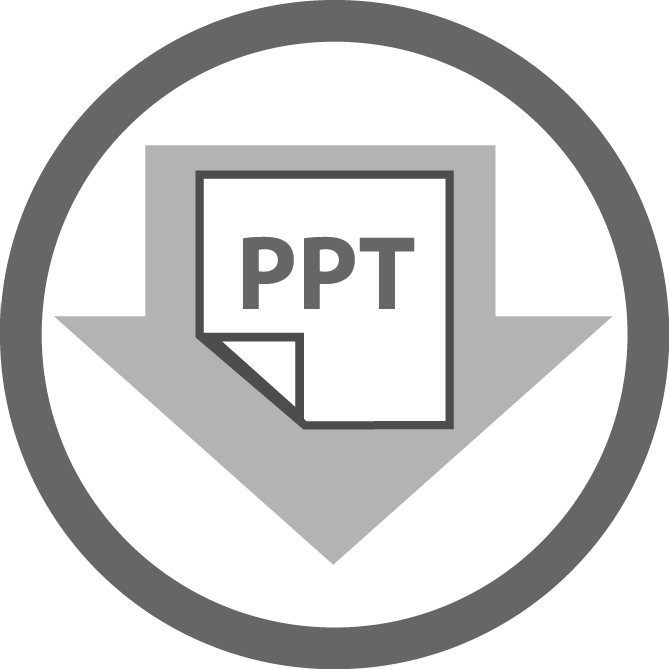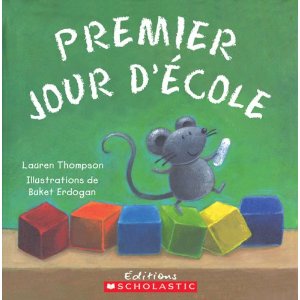by Lauren Thompson
Après s’être cachée dans un sac à dos, petite souris découvre les charmes de l’école maternelle. Qu’est-ce qu’elle va trouver?
Strategies/Skills Used
Reading Strategy 3: Figure out unknown words.
Reading Strategy 4: Self-monitor and self-correct.
 TEACHING THE ACTIVITY: PRE-READING
TEACHING THE ACTIVITY: PRE-READING
(1) Tell students to think-pair-share and imagine/remember their first day of school. What are the important places in our classroom? (Where we sit – le tapis, where we line up – la porte, where we read – le coin de lecture, where we wash our hands – le lavabo, e.g.) What are some things they see in the classroom? (Les livres, les jouets, le tableau, les tables, les chaises, l’horloge, l’ordinateur, e.g.). Provide students with the opportunity to look around the classroom before sharing with their partner and then with the whole class.
(2) Have students work together to develop a vocabulary list using the Word Wall process. The teacher writes the ideas on flashcard strips and places them in a pocket chart. The teacher can add a visual to the flashcards at a later date to help students remember the vocabulary and associate it with an image.
 TEACHING THE ACTIVITY: DURING READING
TEACHING THE ACTIVITY: DURING READING
(3) Read the story Premier jour d’école (Mouse’s first day of school) by Lauren Thompson and explain the more complex French vocabulary so that students understand the story.
(4) Stop and point out any vocabulary words in the story that students had previously generated during the pre-reading brainstorm.
 TEACHING THE ACTIVITY: POST-READING
TEACHING THE ACTIVITY: POST-READING
(5) Review the list students generated of important places around the classroom and items found in the classroom (on another day). Add more words if there are not enough for each student to have their own, or have students share.
 (6) Provide students with their own vocabulary word from the list they generated and tell them they will be responsible for creating a label for the classroom (give them one of the flashcards from the pocket chart). Instruct them to find the letters required on their table (letters should already be cut out) and to glue them on their own classroom label (use the letter handout for the letters.) Tell them once they have finished gluing the letters to draw a picture for the label.
(6) Provide students with their own vocabulary word from the list they generated and tell them they will be responsible for creating a label for the classroom (give them one of the flashcards from the pocket chart). Instruct them to find the letters required on their table (letters should already be cut out) and to glue them on their own classroom label (use the letter handout for the letters.) Tell them once they have finished gluing the letters to draw a picture for the label.
(7) Inform students that their labels will get taped around the classroom to remind them of the vocabulary associated with that space or item. Once they complete them, students can tape up the labels themselves to feel good about their contribution and see how it will be used in the classroom. (It might be a good idea to laminate them so that they can be used all year.) Providing students with the opportunity to create classroom environmental print provides them with an authentic purpose for their labels and scaffolds long-term retrieval of new French vocabulary.
 TEACHING THE ACTIVITY: POST-READING EXTENSIONS
TEACHING THE ACTIVITY: POST-READING EXTENSIONS
(8) Extension 1:
 Using the attached PowerPoint, cut out the mouse from the story (or draw your own), and then place une petite souris around the classroom in various locations. Have students identify where she is by the hints the teacher provides. Students could also take turns moving the mouse around and providing hints to classmates.
Using the attached PowerPoint, cut out the mouse from the story (or draw your own), and then place une petite souris around the classroom in various locations. Have students identify where she is by the hints the teacher provides. Students could also take turns moving the mouse around and providing hints to classmates.
(9) Extension 2: Using the iPad, have students go on a label hunt. Record your voice using the Audio Memo app or another voice recorder app, and instruct students to press play. Once they hear you saying one of the labels, they need to find it and take a picture – similar to a treasure hunt with petite souris in the photo. The following week during centre time, students can use the pictures they have taken with the My Story app to make a story and record their own voice to practice the oral skills associated with the labels.
